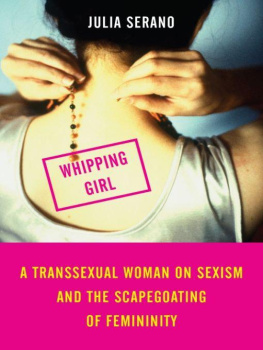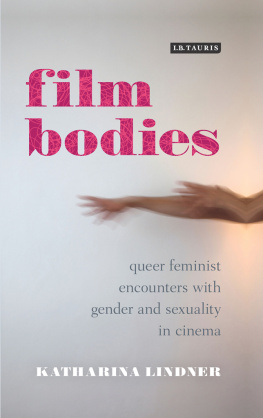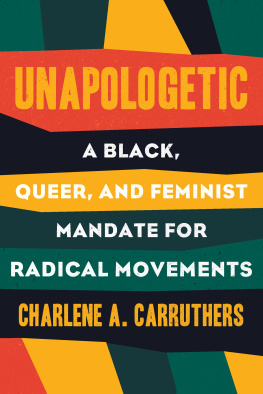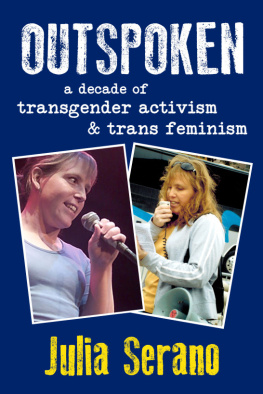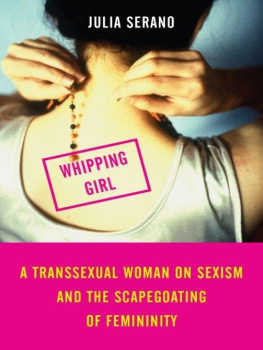Julia Serano - Excluded Making Feminist and Queer Movements More Inclusive
Here you can read online Julia Serano - Excluded Making Feminist and Queer Movements More Inclusive full text of the book (entire story) in english for free. Download pdf and epub, get meaning, cover and reviews about this ebook. year: 2013, genre: Home and family. Description of the work, (preface) as well as reviews are available. Best literature library LitArk.com created for fans of good reading and offers a wide selection of genres:
Romance novel
Science fiction
Adventure
Detective
Science
History
Home and family
Prose
Art
Politics
Computer
Non-fiction
Religion
Business
Children
Humor
Choose a favorite category and find really read worthwhile books. Enjoy immersion in the world of imagination, feel the emotions of the characters or learn something new for yourself, make an fascinating discovery.

- Book:Excluded Making Feminist and Queer Movements More Inclusive
- Author:
- Genre:
- Year:2013
- Rating:3 / 5
- Favourites:Add to favourites
- Your mark:
- 60
- 1
- 2
- 3
- 4
- 5
Excluded Making Feminist and Queer Movements More Inclusive: summary, description and annotation
We offer to read an annotation, description, summary or preface (depends on what the author of the book "Excluded Making Feminist and Queer Movements More Inclusive" wrote himself). If you haven't found the necessary information about the book — write in the comments, we will try to find it.
Julia Serano: author's other books
Who wrote Excluded Making Feminist and Queer Movements More Inclusive? Find out the surname, the name of the author of the book and a list of all author's works by series.
Excluded Making Feminist and Queer Movements More Inclusive — read online for free the complete book (whole text) full work
Below is the text of the book, divided by pages. System saving the place of the last page read, allows you to conveniently read the book "Excluded Making Feminist and Queer Movements More Inclusive" online for free, without having to search again every time where you left off. Put a bookmark, and you can go to the page where you finished reading at any time.
Font size:
Interval:
Bookmark:

EXCLUDED
Making Feminism and Queer Movements More Inclusive
Copyright 2013 Julia Serano
Published by
Seal Press
A Member of the Perseus Books Group
1700 Fourth Street
Berkeley, California
www.sealpress.com
All rights reserved. No part of this book may be reproduced or transmitted in any form without written permission from the publisher, except by reviewers who may quote brief excerpts in connection with a review.
Library of Congress Cataloging-in-Publication Data
Serano, Julia.
Excluded : making feminist and queer movements more inclusive / by Julia
Serano.
pages cm
ISBN 978-1-58005-505-5
1. Feminism. 2. Gay liberation movement. 3. Social isolation. 4. Discrimination.
I. Title.
HQ1101.S47 2013
305.42dc23
2013016145
9 8 7 6 5 4 3 2 1
Cover design by FaceOut Studios
Interior design by Domini Dragoone
Distributed by Publishers Group West
DEDICATION
In loving memory of my mother,
Kate Serano.
I miss your love and friendship.
I miss our long conversations on the phone
or up late at night keeping everyone else
in the house awake. As you always used to
say to me, I miss your face.
CONTENTS
A ll of us have been excluded at some point in our lives. Perhaps because of our size, or class, or age, or race, or nationality, or religion, or education, or interests, or ability. And of course, many of us are excluded because of different forms of sexismthat is, double standards based on ones sex, gender, or sexuality. Many of us are undermined and excluded by our cultures male/masculine-centrismthat is, the assumption that male and masculine people and perspectives are more legitimate than, and take precedence over, female and feminine ones. And those of us who are gender and sexual minorities are stigmatized and excluded by our cultures insistence that only normal bodies, and straight and vanilla expressions of gender and sexuality are valid. This sense of exclusion drives many of us to become involved in feminism and queer (i.e., LGBTQIA+) activism. We seek out like-minded people who share our goals to eliminate sex-, gender-, and sexuality-based hierarchies, and together, we work hard to build new movements and communities with the intent that they will be safe and empowering for those of us who have been shut out of the straight male-centric mainstream. And yet, somewhere along the way, despite our best intentions, the movements and communities that we create almost always end up marginalizing and excluding others who wish to participate.
Sometimes we are consciously aware that exclusion is a bad thing, and we may deny that it is taking place within our feminist or queer circles. We may even resort to tokenismpointing to one or a few minority members in order to make the case that our movement or community is truly diverse. But in other cases, we are blatantly exclusive.
Some feminists vocally condemn other feminists for dressing too femininely, or because of the sexual partners or practices they take up. More mainstream gays decry the presence of drag queens and leather daddies in their pride parades, and there is a long history of lesbians and gay men who outright dismiss bisexual, asexual, and transgender identities. Within the transgender and bisexual umbrellas, there are constant accusations that certain individuals do not qualify as real members of the group, or that their identities or actions somehow reinforce the gender binary (i.e., the rigid division of all people into two mutually exclusive genders). And in most queer communities, regardless of ones sex or identity, people who are more masculine in gender expression are almost always viewed as more valid and attractive than their feminine counterparts.
The astonishing thing about these latter instances of exclusion is not merely their brazen, unapologetic nature, but the fact that they are all steeped in sexismin each case, exclusion is based on the premise that certain ways of being gendered or sexual are more legitimate, natural, or righteous than others. The sad truth is that we always seem to create feminist and queer movements designed to challenge sexism on the one hand, while simultaneously policing gender and sexuality (sometimes just as fiercely as the straight malecentric mainstream does) on the other.
There have been many attempts to reconcile this problem. Newer feminist submovements have sprung up with the expressed purpose of accommodating more diverse expressions of gender and sexuality within feminism. More inclusive umbrella terms such as queer (meant to include all sexual and gender minorities) and transgender (meant to include all people who defy societal gender norms) have come into vogue in an attempt to move away from infighting over identity labels. And what were once simply called lesbian and gay organizations have since added Bs, followed by Ts, then a panoply of other letters at the ends of their acronyms in an attempt to foster inclusiveness. And while all of these measures have brought a modicum of success, sexism-based exclusion still runs rampant in feminist and queer movements.
As a transsexual woman, bisexual, and femme activist, I have spent much of the last ten years challenging various forms of sexism-based exclusion within feminist and queer settings. Over that time, I have come to the conclusion that we cannot Band-Aid over this problem by simply calling for more diversity in a general sense, or by petitioning for the inclusion of specific subgroups on a one-by-one basis. Nor do I think that we can blame this situation entirely on the human tendency to be tribal or cliquish (although admittedly, such us-versus-them mentalities do exacerbate the problem).
Rather, I believe that sexism-based exclusion within feminist and queer circles stems primarily from a handful of foundational, albeit incorrect, assumptions that we routinely make about gender and sexuality, and about sexism and marginalization. These false assumptions infect our theories, our activism, our organizations, and our communities. And they enable us to vigorously protest certain forms of sexism (especially sexisms that we personally face!) while simultaneously ignoring and/or perpetuating other forms of sexism. In short, the way we describe and set out to challenge sexism is irreparably broken. My main purpose in writing this book is to highlight these fallacies in our theory and activism, and to offer new and more accurate ways of thinking about gender and sexism that will avoid the pitfalls of the past.
This book is divided into two parts, the first chronicling instances of sexism-based exclusion within feminism and queer activism, and the second forwarding my proposed solutions to the problem.
The first section, entitled On the Outside Looking In, is a collection of essays, spoken word pieces, and speeches that I have written over the course of an eight-year period (2005-2012), all of which, in one way or another, address the issue of sexism-based exclusion within feminist and queer settings, and offer my early formulations for how we might create more open and accepting movements and communities. It is a journey that begins with my activism fighting for trans womaninclusion in lesbian and womens spaces, and my efforts to articulate trans womens experiences of sexism, both within these settings and in society at large. Later chapters grapple with femme and bisexual exclusion within various LGBTQIA+ settings. To be clear, this section is not meant to provide a comprehensive overview of the problem of exclusion. For one thing, the chapters are centered on practices of sexism-based exclusionthe hypocrisy of policing other peoples gender and sexual identities and behaviors within spaces that were supposedly founded on anti-sexist principles. Furthermore, they focus rather exclusively on forms of exclusion that I have personally faced as a bisexual femme-tomboy transsexual woman. In addition to those identities, I also happen to be a white, middle-class, educated, able-bodiedqueer movements, and this is why I use them as my primary examples over the course of this book.
Next pageFont size:
Interval:
Bookmark:
Similar books «Excluded Making Feminist and Queer Movements More Inclusive»
Look at similar books to Excluded Making Feminist and Queer Movements More Inclusive. We have selected literature similar in name and meaning in the hope of providing readers with more options to find new, interesting, not yet read works.
Discussion, reviews of the book Excluded Making Feminist and Queer Movements More Inclusive and just readers' own opinions. Leave your comments, write what you think about the work, its meaning or the main characters. Specify what exactly you liked and what you didn't like, and why you think so.

